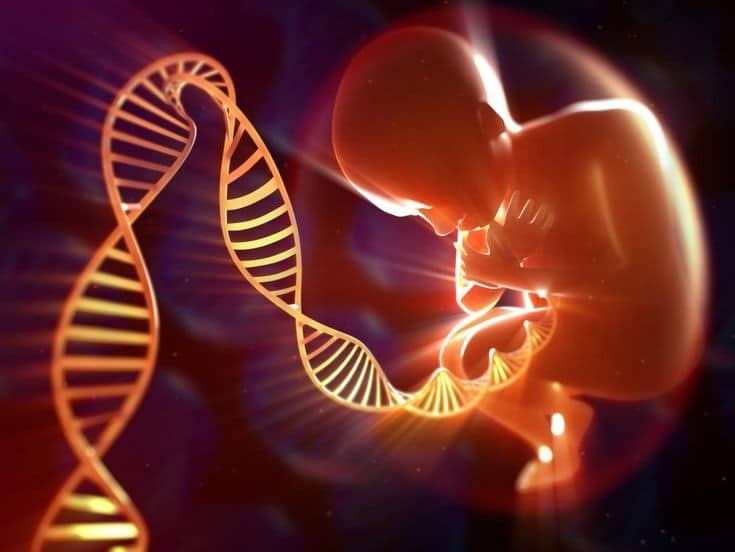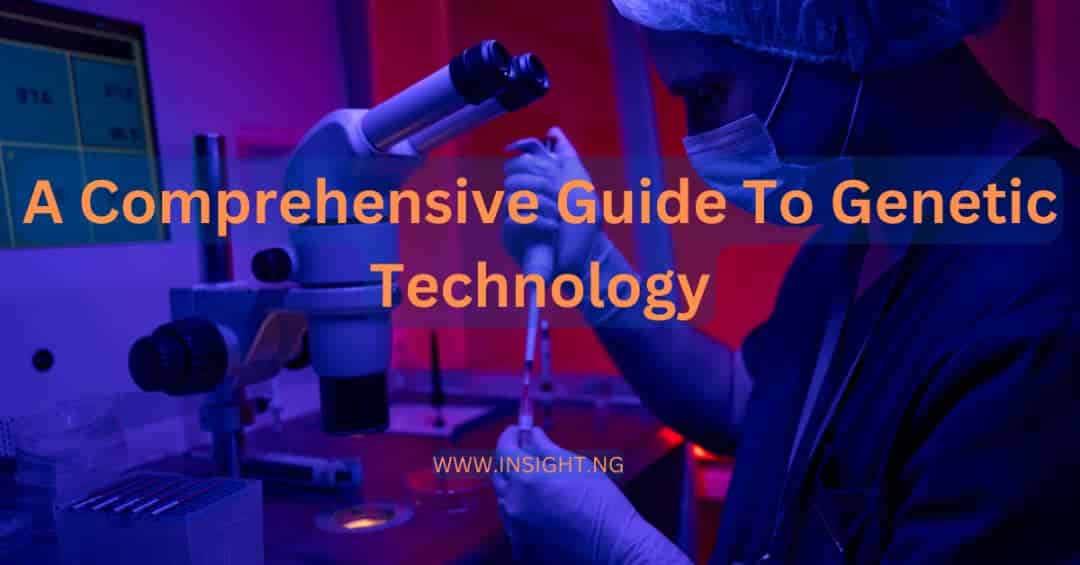Have you heard about genetic technology before but you don’t understand what it means? Or maybe you’re just curious about what genetic engineering is all about, and how it’s done. No matter your reason, you’re in the right place.
This article will give you a clear, and detailed guide, to help you understand genetic technology.
Table of Contents
What is Genetic Technology?
Any tool or technique used to manipulate genes is regarded as genetic technology. Humans, animals, plants, and every other living thing have one major feature in common. This feature is called “genes.”
Genes are like instruction manuals. They tell your body how to grow, and are responsible for your physical characteristics. All things being equal; your skin colour, eye colour, height, and other physical traits are determined by your genes.
Note that our environment and diet can affect how we manifest what’s in our genes. But if the environment is normal, and diet is sufficient, it’s our genes that reign supreme.
Don’t you think it’s prime time to connect with passionate readers and writers like you? Join our WhatsApp community today; you’ll be glad you did.
How Does Genetic Technology Work?

A genetically engineered baby.
The process of using genetic technology to produce desired effects in a species is called genetic engineering. It is the application of our knowledge of genetics to make a human, animal, plant, or any other living thing manifest a certain characteristic that wouldn’t have happened naturally.
For example, a species of apple that is supposed to grow to only 5cm can be genetically engineered to grow to be as large as 25cm. An animal that is supposed to be black can be made to have white skin instead.
This works by altering the genes of the plant or animal. As said earlier, genes are like instruction manuals, they’re like a cookbook the body follows to produce an outcome. If you change the instructions, you automatically change the outcome.
It’s also like making a cake. There are different recipes for different types of cake. If you follow the recipe for a chocolate cake, you will make a chocolate cake. But if you follow the recipe for another type of cake, you’ll never get a chocolate cake, no matter how hard you try.
Thus, if you know the recipes for different types of cakes, you can mix and match them as you please, creating unique blends, flavours, and sizes.
Likewise, if you know the genes of different species, you can alter them, mix, and match them in different ways to give the species unique characteristics that wouldn’t have occurred naturally.
Read also: Becoming a Tech Sister in Nigeria: Thriving in a Booming Industry
Types of Genetic Technology
There are different tools and techniques used at each stage of the genetic engineering process. They include:
-
Gene sequencing technology
Gene sequencing is the process that helps scientists identify all the genes in an organism. It is the first step in the genetic engineering process. Before you can modify something, you need to know its structure and function.
Gene sequencing technologies include:
- Polymerase chain reaction (PCR),
- DNA sequencers, and
- Next-generation sequencers (NGS).
-
Gene isolation technologies
To study the function of individual genes, geneticists have to first isolate them.
Let’s use our cake analogy again. If you want to know how each ingredient in a recipe contributes to the final flavour and texture of a cake, you can decide to bake a cake without that particular ingredient. In effect, you’ve singled out that ingredient and can now determine its function. Gene isolation works similarly. Genes can be isolated using gel electrophoresis.
-
Generation extraction and insertion techniques
After a gene of interest has been isolated, it can be extracted from the donor organism, and inserted into the DNA of a recipient organism. For example, let’s say we want to make another type of fish glow like the jellyfish. After we’ve sequenced the jellyfish’s DNA, and isolated the gene responsible for that glow (let’s call it “glow gene”), we can extract the glow gene, and insert it into the DNA of the other fish that doesn’t glow normally.
The most widely used technology for cutting and extracting genes is CRISPR. Genes can be inserted into an organism via various techniques such as plasmid integration and using a retrovirus to insert the gene. After the gene is inserted into an organism, all that’s left is for the organism to manifest what’s in that gene, for the genetic engineering process to be successful.
Read also: Blockchain for Finance: A Perfect Solution for Nigeria’s Fintech
Benefits of Genetic Technology
Thanks to genetic engineering technologies we can now sequence genes, isolate them, and study them closely in different environments, and under different conditions. Some benefits are:
-
Studying diseases
One benefit of genetic engineering is that it helps us study diseases in ways that wouldn’t have been possible. We can now gain deeper insights into how some diseases develop, how the body tries to counter those disease processes and find possible cures. Sickle cell disease is an example of a disease that gene studies have helped us understand better.
-
Finding cures to diseases
Gene therapy is a promising field. By fixing faulty genes, or replacing them with a healthy gene, some genetic diseases may be cured. Although this isn’t widely adopted yet, there have been some clinical trials with good results.
-
Mass production of important substances
Through genetic engineering, microorganisms can be made to mass produce substances that are important to humans, but are hard to get naturally.
An example is insulin. Insulin is needed to treat diabetes in patients who are not producing enough of it or lack it entirely. Initially, animal insulin was used as treatment. However, it has some disadvantages and could cause immune reactions.
With genetic engineering, scientists were able to insert the gene responsible for creating insulin into microorganisms, and now we have human insulin being mass-produced.
-
Production of genetically modified crops
These are called genetically modified organisms (GMOs). Crops can be enhanced to become resistant to pests and herbicides, to last longer after harvesting, and to contain more nutrients. Altogether, genetic engineering can reduce food production costs, while increasing production rate and durability.
Disadvantages of Genetic Technology
Most of the disadvantages of genetic technologies are associated with their use in the production of genetically modified foods. Also, there is uncertainty about the long-term side effects of genetic engineering in populations. Some disadvantages are given below:
-
Production of unhealthy foods
Genetic engineering of foods is mainly aimed at reducing production costs and increasing production rates, without really considering the health benefits to consumers.
Most ultra-processed foods are manufactured using genetically modified crops. Although this helps to meet the increasing demand at lower costs, it doesn’t give enough nutritional value to consumers.
Furthermore, crops that have been genetically engineered to be herbicide-resistant could accumulate chemicals that are harmful to the body. Without appropriate testing, these could lead to long-term health problems.
-
Risk of antimicrobial resistance (AMR)
Some genetically modified organisms are given the ability to resist antibiotics. This helps researchers separate the organisms that have the new gene from the ones that failed to take it in.
After the genetic engineering process, the organisms are treated with antibiotics. The resistant ones who have manifested the new gene survive, while the ones who failed to manifest the new gene die off.
Without appropriate care and safety measures, these organisms could crossover to human/animal populations, causing illnesses that are unresponsive to antibiotic treatment.
-
Allergic reactions
Since genes are moved across different crop types, which are later used in the production of consumer foods, people could have allergic reactions to foods they consider safe. New proteins could also be produced from the genetic engineering process. These can be sources of new allergens causing unexpected immune responses.
Read also: Smart Home Technology: How it Works and the Benefits
Applications of Genetic Technology
Genetic engineering technologies have been helpful in various fields, particularly in medicine and drug production, agriculture and food production.
-
Medicine
In medicine, genetic engineering is used to study disease processes by replicating them in animal populations. Gene therapy is a growing field, with promising results that could help cure genetic diseases in humans.
Thanks to genetic engineering, human insulin – an important drug in the treatment of diabetes (especially Type 1 diabetes), can be mass-produced by microorganisms. Due to this, there are barely any allergic reactions from its use, compared to when animal insulin from cows and pigs was used.
-
Agriculture
In the agricultural sector, genetic engineering technologies have reduced food production costs, while improving crop yields. Not only that, livestock can be bred at a faster rate, and even have more weight, compared to the ones allowed to grow naturally.
Here in Nigeria, you must have heard people say “agric fowl.” These are a breed of chickens that grow bigger at a faster rate. Although the chickens are not altered genetically, they’re fed genetically modified foods that enhance their growth.
In some parts of the world, cotton has been genetically engineered to be resistant to bollworms, making its growth productive to cotton farmers.
-
Biopharma
Genetic engineering helps in the manufacturing of vaccines, hormones, and antibodies. Drugs can also be tested by replicating disease processes in animals, and monitoring how they respond or react.
Ethical Considerations Concerning Genetic Technology
-
Disclosure
Many ultra-processed foods are manufactured using genetically modified crops. Some consumers are not even aware that genetically engineered foods exist. The ethical dilemma here is whether or not foods containing genetically modified crops should be labelled clearly, informing consumers of what they’re about to eat.
-
Accountability
Every new technology comes with uncertainty and is approached with scepticism. The full extent of the effects caused by genetic engineering is not yet known.
New diseases could be created in trying to cure existing ones. The issue of holding companies and researchers accountable cannot be overlooked. Also, regulations need to be standardized and strengthened, to ensure bad actors don’t exploit genetic technology for activities that are detrimental to society.
The Future of Genetic Technology
Although these are speculations and have to go through a series of testing and regulations before use is approved in humans, the future of genetic technology is, however, exciting. Some things to look out for include:
-
Organ production
Organs like the kidneys, liver, and heart, could be made in laboratories. If this is perfected and adopted, hundreds of thousands of people who need organ donors could be saved.
-
Cure of genetic diseases
Diseases that are caused by damage to one’s genes could be routinely cured by genetic engineering techniques.
-
Slows down ageing
We’re still far away from this, but it’s an exciting thing to dream about. In the future, we could slow down ageing through genetic engineering.
-
Mass production of environmentally friendly plant-derived substances
Some scientists have already tried producing rubber from microorganisms through genetic engineering. With improvement in the process, natural rubber could be mass-produced without relying on plants alone.
If you don’t mind receiving technology insights like this in your inbox, you can subscribe to our newsletter and let’s keep you posted.
Conclusion
Genetic technology has contributed its 2 cents (or maybe more) in advancing the world. From helping us understand disease processes better, to mass producing important substances like insulin needed for the treatment of diabetes.
The future holds great promise, as we might be able to cure some diseases that are currently incurable, increase the production of nutrient-rich foods at a lower cost, or even make some organic products that are hard to get in nature.
But we need to be cautious though, as there are some risks associated with its use. Measures must be in place to ensure the benefits we’re trying to get are not overshadowed by unforeseen damage.
Edited by Priscilla Ajayi.
About Author

-
Tari Yousuo is an SEO specialist and content writer, writing about Tech and IT, Cloud Computing, AI, and Marketing.
When he's not digging deep into tech and the digital world, you can find him absorbing the beauty of nature or playing with poetry.
Latest entries


 CareerApril 18, 2024The Impacts of AI and Automation on Different Careers in Nigeria
CareerApril 18, 2024The Impacts of AI and Automation on Different Careers in Nigeria

